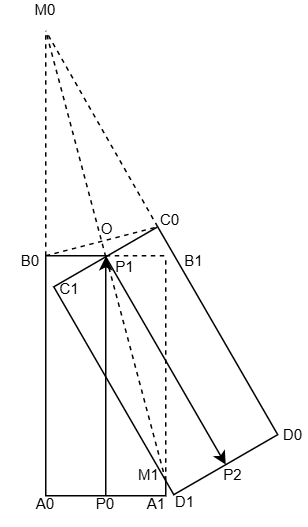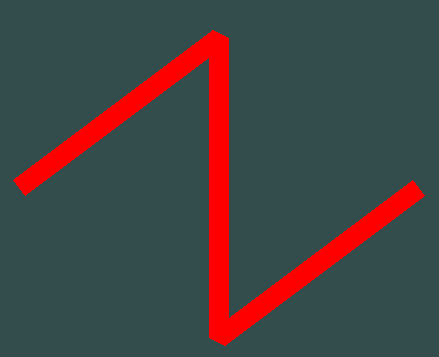Overview
In the previous post I prepared the code for join styles implementation. But after geometry shader performance testing I decided to make a version with geometry shader.
Implementation
Join styles
There are three join styles:
- bevel
- miter
- round
Bevel join style
The bevel join style fills the triangular notch between the two lines.
Miter join style
The miter join style extends the lines to meet at an angle.
Round join style
The round join style fills a circular arc between the two lines. This style has been implemented earlier.
Miter point calculation
To calculate miter point we need to know a direction before the join and a direction after.

In the provided figure we have join point $P_1$, previous point $P_0$ and next point $P_2$. Miter point $M_0$ has it’s opposite point $M_1$ of quads intersection.
- Points $A_0$ and $A_1$ are derived from first segment point $P_0$.
- Points $B_0$ and $B_1$ are derived from first segment point $P_1$.
- Points $C_0$ and $C_1$ are derived from second segment point $P_1$.
- Points $D_0$ and $D_1$ are derived from second segment point $P_2$.
Let’s define segments directions:
\[\begin{cases} d_1 = P_1 - P_0 \\ d_2 = P_2 - P_1 \end{cases} \tag{1}\label{1}\]and angles:
\[\begin{cases} \alpha = \widehat{B_0 M_0 C_0} \\ \beta = \frac \alpha 2 \end{cases} \tag{2}\label{2}\]Angle between directions:
\[\cos{\alpha} = - \vec{d_1} \cdot \vec{d_2}\]For quad halfwidth $w$ distance to miter point $l$:
\[l = B_0 M_0 = \frac {w} {\tan{\beta}}\] \[l = w \frac {\cos{\beta}} {\sin{\beta}}\] \[l = w \sqrt{\frac{1+\cos{\alpha}}{1-\cos{\alpha}}}\]And $M_0$ will be computed as:
\[M_0 = B_0 + \vec{d_1} l\]Restrictions
Miter point can’t be calculated for angle $\alpha$ close to zero. Also we should define miter limit $l_{\max}$. So there will be following restrictions:
\[\begin{cases} l \le l_{\max} \\ \alpha \ge \alpha_\min \end{cases} \tag{3}\label{3}\]Code
Application code
Data creation
bool PolylineDrawer::CreateData(const PointArray& points)
{
uint32_t num_points = static_cast<uint32_t>(points.size());
if (num_points < 2) return false;
// We add one point before and one point after to have access to previous and next segments.
num_vertices_ = num_points + 2;
vertices_array_ = new uint8_t[num_vertices_ * sizeof(Vertex)];
Vertex* vertices = reinterpret_cast<Vertex*>(vertices_array_);
// Position
uint32_t n = 0;
// First point is extrapolated one from the first segment.
Point first_point;
first_point[0] = points[0][0] + (points[0][0] - points[1][0]);
first_point[1] = points[0][1] + (points[0][1] - points[1][1]);
vertices[n++].position = first_point;
for (uint32_t i = 0; i < num_points; ++i)
{
const Point& point = points[i];
vertices[n++].position = {point[0], point[1]};
}
// The last point is extrapolated one from the last segment.
Point last_point;
last_point[0] = points[num_points-1][0] + (points[num_points-1][0] - points[num_points-2][0]);
last_point[1] = points[num_points-1][1] + (points[num_points-1][1] - points[num_points-2][1]);
vertices[n++].position = last_point;
// Point type
n = 0;
vertices[n++].point_type = 0.0f; // value here doesn't matter
for (uint32_t i = 0; i < num_points; ++i)
{
vertices[n++].point_type = (i == 0) ? -1.0f : (i == num_points - 1) ? 1.0f : 0.0f;
}
vertices[n++].point_type = 0.0f; // value here doesn't matter
return true;
}
Attributes layout
const GLsizei stride = sizeof(Vertex);
const uint8_t* base = nullptr;
const uint8_t* prev_offset = base;
const uint8_t* curr_offset = prev_offset + stride;
const uint8_t* next_offset = curr_offset + stride;
const uint8_t* point_type_curr_offset = curr_offset + sizeof(Point);
const uint8_t* point_type_next_offset = point_type_curr_offset + stride;
glVertexAttribPointer(0, 2, GL_FLOAT, GL_FALSE, stride, prev_offset); // vec2 a_position_prev
glEnableVertexAttribArray(0);
glVertexAttribPointer(1, 2, GL_FLOAT, GL_FALSE, stride, curr_offset); // vec2 a_position_curr
glEnableVertexAttribArray(1);
glVertexAttribPointer(2, 2, GL_FLOAT, GL_FALSE, stride, next_offset); // vec2 a_position_next
glEnableVertexAttribArray(2);
glVertexAttribPointer(3, 1, GL_FLOAT, GL_FALSE, stride, point_type_curr_offset); // float a_point_type_curr
glEnableVertexAttribArray(3);
glVertexAttribPointer(4, 1, GL_FLOAT, GL_FALSE, stride, point_type_next_offset); // float a_point_type_next
glEnableVertexAttribArray(4);
Rendering
void PolylineDrawer::Render()
{
ActivateShader();
glBindVertexArray(vertex_array_object_);
glDrawArrays(GL_POINTS, 0, num_vertices_ - 3);
glBindVertexArray(0);
DeactivateShader();
}
Shader code
Vertex shader
#version 330 core
layout (location = 0) in vec2 a_position_prev;
layout (location = 1) in vec2 a_position_curr;
layout (location = 2) in vec2 a_position_next;
layout (location = 3) in float a_point_type_curr;
layout (location = 4) in float a_point_type_next;
out VS_OUT {
vec4 position_prev;
vec4 position_next;
float point_type_curr;
float point_type_next;
} vs_out;
void main()
{
gl_Position = vec4(a_position_curr, 0.0, 1.0);
vs_out.position_prev = vec4(a_position_prev, 0.0, 1.0);
vs_out.position_next = vec4(a_position_next, 0.0, 1.0);
vs_out.point_type_curr = a_point_type_curr;
vs_out.point_type_next = a_point_type_next;
}
Geometry shader
#version 330 core
layout (points) in;
layout (triangle_strip, max_vertices = 8) out;
uniform vec4 u_viewport;
uniform float u_pixel_width;
uniform float u_miter_limit;
uniform int u_cap_style; // flat, square, round
uniform int u_join_style; // bevel, miter, round
in VS_OUT {
vec4 position_prev;
vec4 position_next;
float point_type_curr;
float point_type_next;
} gs_in[];
noperspective out vec2 v_position;
noperspective out float v_point_type;
flat out float v_length;
flat out float v_radius;
vec2 project(vec4 clip)
{
vec3 ndc = clip.xyz / clip.w;
vec2 screen = (ndc.xy * 0.5 + vec2(0.5)) * u_viewport.zw + u_viewport.xy;
return screen;
}
vec4 unproject(vec2 screen, float z, float w)
{
vec2 ndc = ((screen - u_viewport.xy) / u_viewport.zw - vec2(0.5)) * 2.0;
return vec4(ndc.x * w, ndc.y * w, z, w);
}
// We draw quad from current point to next one
void build_quad(vec4 prev, vec4 curr, vec4 next)
{
vec2 screen_prev = project(prev);
vec2 screen_curr = project(curr);
vec2 screen_next = project(next);
vec2 d1 = normalize(screen_curr - screen_prev);
vec2 n1 = vec2(-d1.y, d1.x);
vec2 d2 = screen_next - screen_curr;
float segment_length = length(d2);
d2 /= segment_length; // normalize
vec2 n2 = vec2(-d2.y, d2.x);
float w = u_pixel_width * 0.5;
float point_type_curr = gs_in[0].point_type_curr;
float point_type_next = gs_in[0].point_type_next;
if (abs(point_type_curr) < 0.5) // current point is join, not start point
{
if (u_join_style == 0) // bevel join
{
// Bevel triangle
float signed_z = w * sign(d1.x*d2.y - d2.x*d1.y);
gl_Position = unproject(screen_curr - n1 * signed_z, curr.z, curr.w);
v_position = vec2(0.0);
v_point_type = 0.0;
v_length = segment_length;
v_radius = w;
EmitVertex();
gl_Position = unproject(screen_curr - n2 * signed_z, curr.z, curr.w);
v_position = vec2(0.0);
v_point_type = 0.0;
v_length = segment_length;
v_radius = w;
EmitVertex();
gl_Position = curr;
v_position = vec2(0.0);
v_point_type = 0.0;
v_length = segment_length;
v_radius = w;
EmitVertex();
EndPrimitive();
}
else if (u_join_style == 1) // miter join
{
// Miter quad
float cos_a = dot(-d1, d2);
float miter_limit = u_miter_limit * w;
float miter_distance = w * sqrt((1.0 + cos_a) / (1.0 - cos_a));
if (cos_a < 0.98 && miter_distance < miter_limit)
{
float signed_z = w * sign(d1.x*d2.y - d2.x*d1.y);
vec2 first_point = screen_curr - n1 * signed_z;
vec2 second_point = screen_curr - n2 * signed_z;
vec2 miter_point = first_point + d1 * miter_distance;
gl_Position = unproject(first_point, curr.z, curr.w);
v_position = vec2(0.0);
v_point_type = 0.0;
v_length = segment_length;
v_radius = w;
EmitVertex();
gl_Position = curr;
v_position = vec2(0.0);
v_point_type = 0.0;
v_length = segment_length;
v_radius = w;
EmitVertex();
gl_Position = unproject(miter_point, curr.z, curr.w);
v_position = vec2(0.0);
v_point_type = 0.0;
v_length = segment_length;
v_radius = w;
EmitVertex();
gl_Position = unproject(second_point, curr.z, curr.w);
v_position = vec2(0.0);
v_point_type = 0.0;
v_length = segment_length;
v_radius = w;
EmitVertex();
EndPrimitive();
}
}
else // round join
{
vec2 p1 = screen_curr + n2 * w;
vec2 p2 = p1 - d2 * w;
vec2 p3 = screen_curr - n2 * w;
vec2 p4 = p3 - d2 * w;
gl_Position = unproject(p1, curr.z, curr.w);
v_position = vec2(0.0, w);
v_point_type = point_type_curr;
v_length = segment_length;
v_radius = w;
EmitVertex();
gl_Position = unproject(p2, curr.z, curr.w);
v_position = vec2(-w, w);
v_point_type = point_type_curr;
v_length = segment_length;
v_radius = w;
EmitVertex();
gl_Position = unproject(p3, curr.z, curr.w);
v_position = vec2(0.0, -w);
v_point_type = point_type_curr;
v_length = segment_length;
v_radius = w;
EmitVertex();
gl_Position = unproject(p4, curr.z, curr.w);
v_position = vec2(-w, -w);
v_point_type = point_type_curr;
v_length = segment_length;
v_radius = w;
EmitVertex();
EndPrimitive();
}
}
vec2 curr_offset_x = vec2(0.0);
vec2 next_offset_x = vec2(0.0);
vec2 offset_y = n2 * w;
float cap_offset_curr = 0.0;
float cap_offset_next = 0.0;
if (u_cap_style != 0) // not flat cap (square cap or round cap)
{
cap_offset_curr = w * point_type_curr;
cap_offset_next = w * point_type_next;
curr_offset_x = d2 * cap_offset_curr;
next_offset_x = d2 * cap_offset_next;
}
// Quad
gl_Position = unproject(screen_curr + offset_y + curr_offset_x, curr.z, curr.w); // left top
v_position = vec2(cap_offset_curr, w);
v_point_type = point_type_curr;
v_length = segment_length;
v_radius = w;
EmitVertex();
gl_Position = unproject(screen_curr - offset_y + curr_offset_x, curr.z, curr.w); // left bottom
v_position = vec2(cap_offset_curr, -w);
v_point_type = point_type_curr;
v_length = segment_length;
v_radius = w;
EmitVertex();
gl_Position = unproject(screen_next + offset_y + next_offset_x, next.z, next.w); // right top
v_position = vec2(segment_length + cap_offset_next, w);
v_point_type = point_type_next;
v_length = segment_length;
v_radius = w;
EmitVertex();
gl_Position = unproject(screen_next - offset_y + next_offset_x, next.z, next.w); // right bottom
v_position = vec2(segment_length + cap_offset_next, -w);
v_point_type = point_type_next;
v_length = segment_length;
v_radius = w;
EmitVertex();
EndPrimitive();
}
void main()
{
build_quad(gs_in[0].position_prev, gl_in[0].gl_Position, gs_in[0].position_next);
}
Fragment shader
#version 330 core
uniform int u_cap_style; // flat, square, round
uniform int u_join_style; // bevel, miter, round
out vec4 color;
noperspective in vec2 v_position;
noperspective in float v_point_type;
flat in float v_length;
flat in float v_radius;
void main()
{
vec2 position = v_position;
float point_type = v_point_type;
float len = v_length;
float radius = v_radius;
bool is_join = abs(point_type) < 0.5;
bool need_discard = !is_join && u_cap_style == 2 || is_join && u_join_style == 2;
if (need_discard && position.x < 0.0)
{
float dist = length(position); // = distance(position, vec2(0.0))
if (dist > radius)
discard;
}
else if (need_discard && position.x > len)
{
float dist = length(vec2(position.x - len, position.y)); // = distance(position, vec2(len, 0.0))
if (dist > radius)
discard;
}
color = vec4(1.0, 0.0, 0.0, 0.0);
}
Conclusion

We achieved polyline rendering with different joins. In the next post we will cover polyline rendering with dash pattern.
